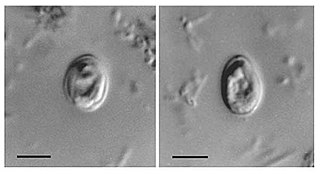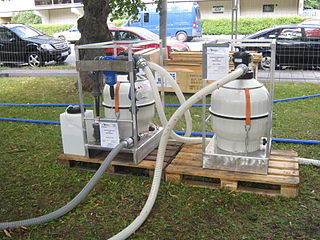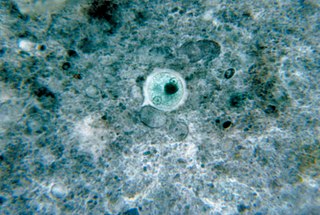Related Research Articles

Giardia is a genus of anaerobic flagellated protozoan parasites of the phylum Metamonada that colonise and reproduce in the small intestines of several vertebrates, causing the disease giardiasis. Their life cycle alternates between a swimming trophozoite and an infective, resistant cyst. Giardia were first described by the Dutch microscopist Antonie van Leeuwenhoek in 1681. The genus is named after French zoologist Alfred Mathieu Giard.

Giardia duodenalis, also known as Giardia intestinalis and Giardia lamblia, is a flagellated parasitic protozoan microorganism of the genus Giardia that colonizes the small intestine, causing a diarrheal condition known as giardiasis. The parasite attaches to the intestinal epithelium by an adhesive disc or sucker, and reproduces via binary fission. Giardiasis does not spread to other parts of the gastrointestinal tract, but remains confined to the lumen of the small intestine. The microorganism has an outer membrane that makes it possible to survive even when outside of its host, and which can render it tolerant to certain disinfectants. Giardia trophozoites are anaerobic, and absorb their nutrients from the intestinal lumen. If the organism is stained, its characteristic pattern resembles the familiar "smiley face" symbol.

Cryptosporidiosis, sometimes informally called crypto, is a parasitic disease caused by Cryptosporidium, a genus of protozoan parasites in the phylum Apicomplexa. It affects the distal small intestine and can affect the respiratory tract in both immunocompetent and immunocompromised individuals, resulting in watery diarrhea with or without an unexplained cough. In immunosuppressed individuals, the symptoms are particularly severe and can be fatal. It is primarily spread through the fecal-oral route, often through contaminated water; recent evidence suggests that it can also be transmitted via fomites contaminated with respiratory secretions.

A parasitic disease, also known as parasitosis, is an infectious disease caused by parasites. Parasites are organisms which derive sustenance from its host while causing it harm. The study of parasites and parasitic diseases is known as parasitology. Medical parasitology is concerned with three major groups of parasites: parasitic protozoa, helminths, and parasitic arthropods. Parasitic diseases are thus considered those diseases that are caused by pathogens belonging taxonomically to either the animal kingdom, or the protozoan kingdom.

Parasitology is the study of parasites, their hosts, and the relationship between them. As a biological discipline, the scope of parasitology is not determined by the organism or environment in question but by their way of life. This means it forms a synthesis of other disciplines, and draws on techniques from fields such as cell biology, bioinformatics, biochemistry, molecular biology, immunology, genetics, evolution and ecology.

Giardiasis is a parasitic disease caused by Giardia duodenalis. Infected individuals who experience symptoms may have diarrhoea, abdominal pain, and weight loss. Less common symptoms include vomiting and blood in the stool. Symptoms usually begin one to three weeks after exposure and, without treatment, may last two to six weeks or longer.

Trichomonas vaginalis is an anaerobic, flagellated protozoan parasite and the causative agent of a sexually transmitted disease called trichomoniasis. It is the most common pathogenic protozoan that infects humans in industrialized countries. Infection rates in men and women are similar but women are usually symptomatic, while infections in men are usually asymptomatic. Transmission usually occurs via direct, skin-to-skin contact with an infected individual, most often through vaginal intercourse. The WHO has estimated that 160 million cases of infection are acquired annually worldwide. The estimates for North America alone are between 5 and 8 million new infections each year, with an estimated rate of asymptomatic cases as high as 50%. Usually treatment consists of metronidazole and tinidazole.

Cryptosporidium, sometimes called crypto, is an apicomplexan genus of alveolates which are parasites that can cause a respiratory and gastrointestinal illness (cryptosporidiosis) that primarily involves watery diarrhea, sometimes with a persistent cough.
The 1993 Milwaukee cryptosporidiosis outbreak was a significant distribution of the Cryptosporidium protozoan in Milwaukee, Wisconsin, and the largest waterborne disease outbreak in documented United States history. It is suspected that The Howard Avenue Water Purification Plant, one of two water treatment plants in Milwaukee at the time, was contaminated. It is believed that the contamination was due to an ineffective filtration process. Approximately 403,000 residents were affected resulting in illness and hospitalization. Immediate repairs were made to the treatment facilities along with continued infrastructure upgrades during the 25 years since the outbreak. The total cost of the outbreak, in productivity loss and medical expenses, was $96 million. At least 69 people died as a result of the outbreak. The city of Milwaukee has spent upwards to $510 million in repairs, upgrades, and outreach to citizens.

Portable water purification devices are self-contained, easily transported units used to purify water from untreated sources for drinking purposes. Their main function is to eliminate pathogens, and often also of suspended solids and some unpalatable or toxic compounds.
The discovery of disease-causing pathogens is an important activity in the field of medical science. Many viruses, bacteria, protozoa, fungi, helminths, and prions are identified as a confirmed or potential pathogen. In the United States, a Centers for Disease Control and Prevention program, begun in 1995, identified over a hundred patients with life-threatening illnesses that were considered to be of an infectious cause but that could not be linked to a known pathogen. The association of pathogens with disease can be a complex and controversial process, in some cases requiring decades or even centuries to achieve.

A microbial cyst is a resting or dormant stage of a microorganism, that can be thought of as a state of suspended animation in which the metabolic processes of the cell are slowed and the cell ceases all activities like feeding and locomotion. Many groups of single-celled, microscopic organisms, or microbes, possess the ability to enter this dormant state.

The Eukaryotic Pathgen Database, or EuPathDB, is a database of bioinformatic and experimental data related to a variety of eukaryotic pathogens. It was established in 2006 under a National Institutes of Health program to create Bioinformatics Resource Centers to facilitate research on pathogens that may pose biodefense threats. EuPathDB stores data related to its organisms of interest and provides tools for searching through and analyzing the data. It currently consists of 14 component databases, each dedicated to a certain research topic. EuPathDB includes:
Carcinogenic parasites are parasitic organisms that depend on other organisms for their survival, and cause cancer in such hosts. Three species of flukes (trematodes) are medically-proven carcinogenic parasites, namely the urinary blood fluke, the Southeast Asian liver fluke and the Chinese liver fluke. S. haematobium is prevalent in Africa and the Middle East, and is the leading cause of bladder cancer. O. viverrini and C. sinensis are both found in eastern and southeastern Asia, and are responsible for cholangiocarcinoma. The International Agency for Research on Cancer declared them in 2009 as a Group 1 biological carcinogens in humans.
Alan Frederick Cowman AC, FRS, FAA, CorrFRSE, FAAHMS, FASP, FASM is an internationally acclaimed malaria researcher whose work specialises in researching the malaria-causing parasite, Plasmodium falciparum, and the molecular mechanisms it uses to evade host responses and antimalarial drugs. As of May 2024, he is the deputy directory and Laboratory Head of the Walter and Eliza Hall Institute of Medical Research (WEHI) in Melbourne, and his laboratory continues to work on understanding how Plasmodium falciparum, infects humans and causes disease. He was elected as a fellow of the Royal Society in 2011 and awarded the Companion of the Order of Australia in 2019 for his "eminent service to the biological sciences, notably to molecular parasitology, to medical research and scientific education, and as a mentor."
Cryptosporidium varanii is a protozoal parasite that infects the gastrointestinal tract of lizards. C. varanii is often shed in the feces, and transmission is primarily via fecal-oral route. Unlike Cryptosporidium serpentis, C. varanii does not colonize the stomach, but rather the intestines of most infected lizards, such as geckos. An exception to this rule are monitor lizards, as gastric (stomach) lesions have been found in those species. Oocysts of lizard Cryptosporidium are larger than the snake counterpart.
Cryptosporidium serpentis is a protozoal parasite that infects the gastrointestinal tract of snakes. Sporated oocysts of C. serpentis are intermittently shed in the feces, and transmission is primarily via fecal-oral route. C. serpentis is a gastric parasite, primarily colonizing the stomach. Unlike mammalian Cryptosporidium - that is usually self-limiting - C. serpentis remains chronic and in most cases, eventually lethal in snakes once an animal has become symptomatic. However, recent advancements in detection have led to the identification of healthy carrier animals some of which have thus far remained in good health for years and cast doubt on previous assumptions about the lethality of the parasite, though it remains to be seen how many carriers will remain healthy and for how long as most such animals are euthanized immediately. Cryptosporidiosis infection has been documented in a variety of snake species worldwide, such as North American Corn snakes and Australian Taipans, both free-living and captive. Necropsy examinations of expired captive snakes infected with C. serpentis note characteristic gastric mucosal hypertrophy that, in time, narrows the gastric lumen, resulting in classic symptoms of repetitive regurgitation and anorexia. Due to the enlargement of the stomach lining, a noticeable midbody bulge can be palpable and commonly visible. Frequent mucoid stools have been reported. However, some snakes will display no external symptoms at all throughout their lifetime, yet still remain infectious to counterparts.
Keith Roland Matthews,, , is a British cell biologist and parasitologist, currently Professor of Parasite Biology in the School of Biological Sciences at the University of Edinburgh. His research focuses on African trypanosomes, which cause human sleeping sickness and the equivalent cattle disease nagana.
Giardia microti is a species of Diplomonad parasitic protozoan. Its hosts mainly consist of rodents in the family Cricetidae, which includes voles, mice, rats and muskrats, although they have also been detected from fish.
References
- 1 2 3 "2000 Minister's Prize". Canberra, Australia: Department of Industry, Government of Australia. 2000. Retrieved 13 November 2015.
- 1 2 3 "Symposium: A celebration of Australian science". Acton, Australian Capital Territory, Australia: Australian Academy of Science. 7 May 2004. Retrieved 13 November 2015.
- 1 2 "Biology of Foodborne Parasites". Norway: Akademika Norway. Retrieved 15 November 2015.
- ↑ "Project Number # 1068 Understanding and limiting the public health risks of Cryptosporidium and Giardia in animals in Australian catchments". Water Research Australia. Retrieved 13 November 2015.
- ↑ "2000 Recipients". Canberra, Australia: Australian Government: Department of Industry, Innovation and Science. Retrieved 14 November 2015.
- ↑ "Prime Minister's Prizes for Science". Canberra, Australia: Australian Government departments: Department of Industry, Innovation and Science. Retrieved 14 November 2015.
- ↑ "Congratulations to 2021 ASP Fellow, Una Ryan". Australian Society for Parasitology. 29 July 2021. Retrieved 17 June 2023.
- ↑ "Associate Professor Una M Ryan". Australian Research Network for Parastology. 2008. Retrieved 13 November 2015.
- ↑ Ryan, UM; Bath, C; Robertson, I; Read, C; Elliot, A; McInnes, L; Traub, R; Besier, B (September 2005). "Sheep may not be an important zoonotic reservoir for Cryptosporidium and Giardia parasites". Appl Environ Microbiol. 71 (9): 4992–7. Bibcode:2005ApEnM..71.4992R. doi:10.1128/AEM.71.9.4992-4997.2005. PMC 1214644 . PMID 16151078.
- ↑ "Professor Una Ryan". Australian Honours Search Facility. Retrieved 10 June 2024.